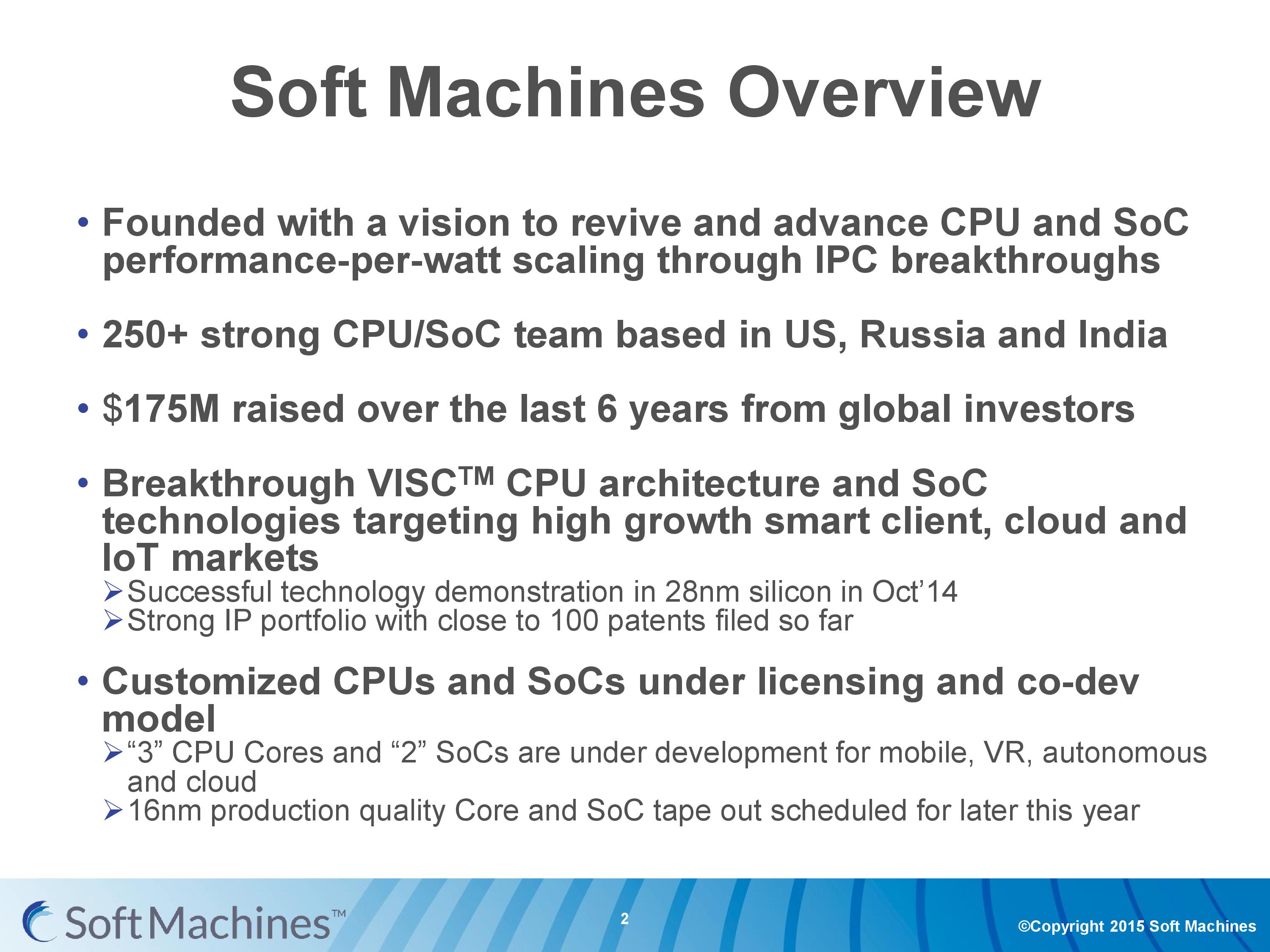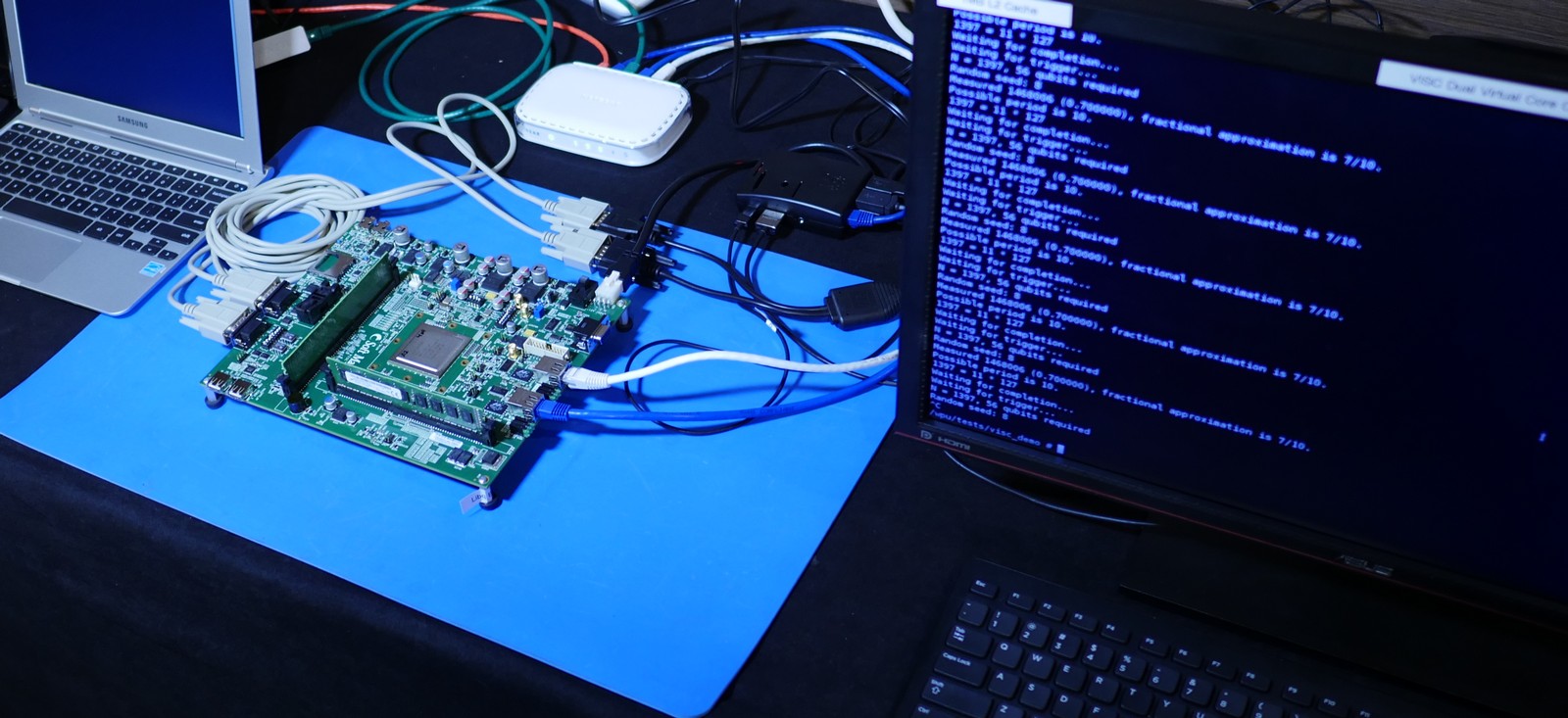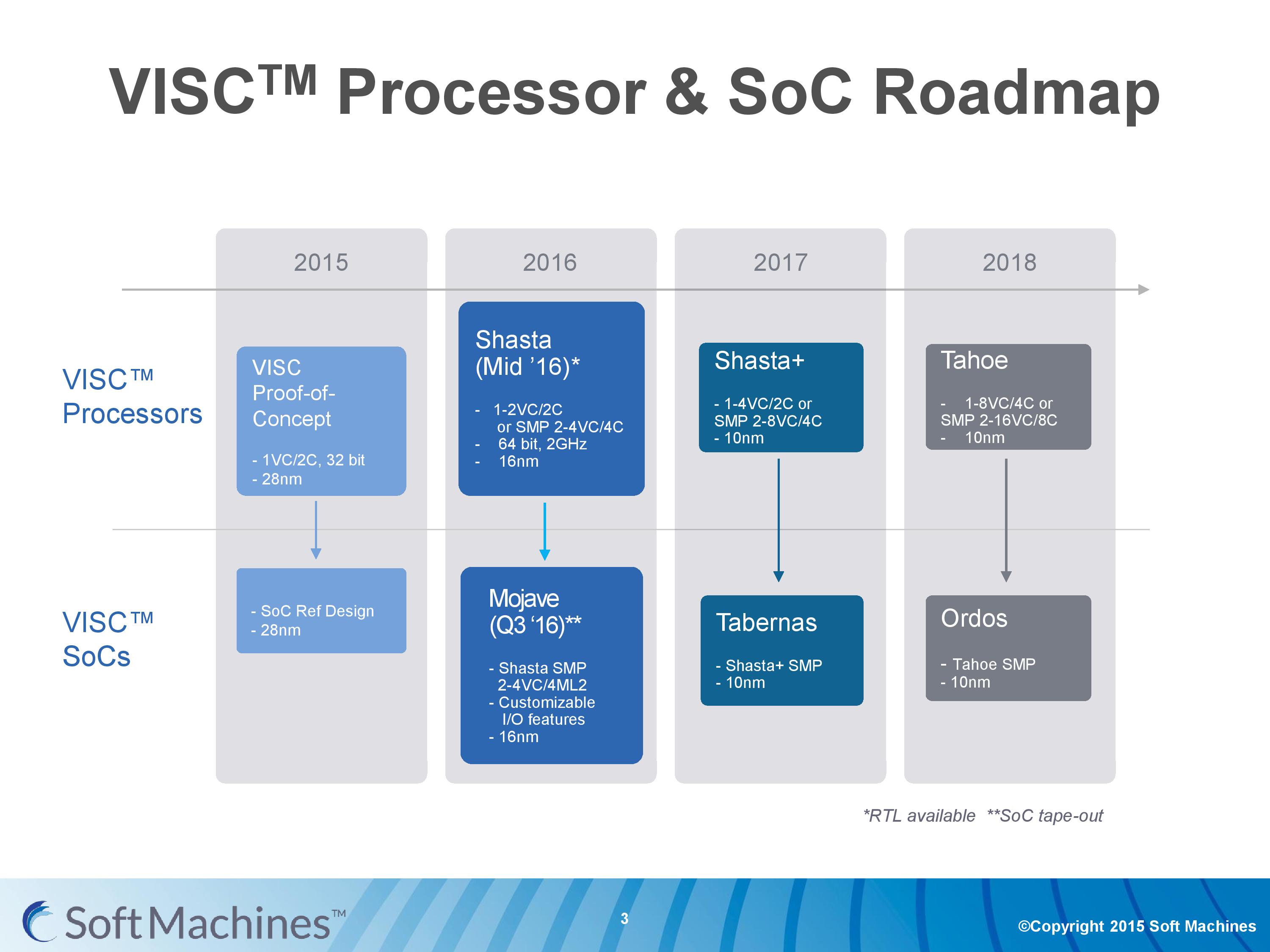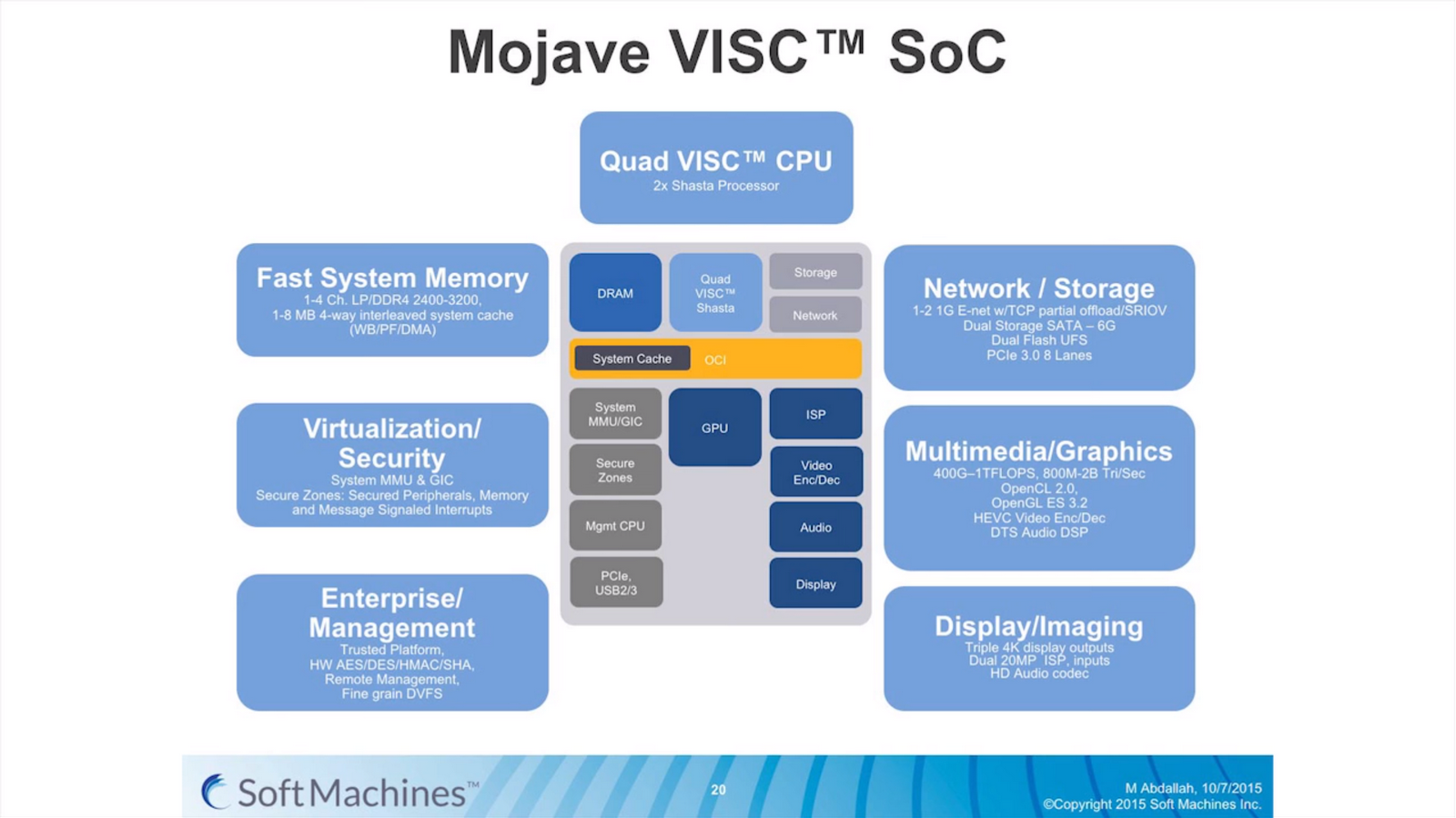Examining Soft Machines' Architecture: An Element of VISC to Improving IPC
by Ian Cutress on February 12, 2016 8:00 AM EST- Posted in
- CPUs
- Arm
- x86
- Architecture
- Soft Machines
- IPC
Soft Machines
To put it succinctly, having a thread take resources from multiple cores - when the performance can be extracted - sounds like the long-desired solution to the problem making multi-core designs more useful in lightly-threaded scenarios. Having multiple threads use resources on a single core on the same clock cycle is an even bigger leap in the same direction. Now obviously Soft Machines didn’t come up with this overnight.
Soft Machines came out of stealth mode at the 2014 Linley Conference. Their main goal was to increase performance-per-watt using better IPC designs, which is often one of the better ways if you can keep a design fed with data. One big challenge to this is that IPC has been somewhat flat these past few years - we're seeing small sub-10% yearly increases from the big players using standard designs. Soft Machines were already six years old at the time, with $150M+ raised from investors that include Samsung Ventures, GlobalFoundries, AMD, Mubadala and others (with another $25M since). If those names all seem interlinked, it’s because they all have historic business or investment dealings with each other (AMD/GloFo, Samsung/GloFo, AMD/Mubadala etc.). The team at Soft Machines is 250+ strong, with ex Intel, ex Qualcomm, ex AMD engineers on staff from processor design to platform architects. Half the staff is currently located in California.
At the 2014 conference, aside from explaining what they were doing, Soft Machines also exhibited working silicon of their design. The first generation proof of concept was fabbed at 28nm at TSMC and running at 500 MHz.
It seems odd to say that it was done at TSMC, especially with Samsung and Global Foundries as investors. We were told that this was due to timing and positioning with IP more than anything else, and the same is true for the next generation at 16nm FF+, rather than 14nm.
VISC and Roadmaps
The first generation chip wasn’t perfect – there were some design flaws in silicon that required specific workarounds relating to cache flushing and various methods, but at the time it was compared to a single thread Cortex A15 running at a similar frequency in a Samsung processor. The results with SPEC2000, SPEC2006, Denbench and Kraken gave a corresponding IPC relative to A15 of 1.5x to 7x, or as Soft Machines likes to put it: 3-4x "on average." It was estimated that access to a second physical core improves performance by an average of 50-60%, or an average IPC of 1.3 per core compared to 0.71 for Cortex A15, which explains the 3-4x average.
The roadmap for Soft Machines put their second generation VISC core, Shasta, in line for 2016. It was formally announced at the 2015 Linley Conference, with this month’s announcement being more about availability for licensing on 16FF+. The Shasta core on this node is designed as a 2C/2VC design, or two of these can be put together using a custom protocol interconnect to form a dual 2C/2VC design.
The custom interconnect fabric here is capable of over 200 GB/s, although in current designs only a single interface is present, allowing only two chips to be connected.
The dual processor design is going to be part of the Mojave IP as a fully integrated SoC.
Along with the requisite VISC cores, the Mojave SoC includes PowerVR graphics, a DDR4 memory controller, virtualization management, a PCIe root complex capable of eight lanes of PCIe 3.0, USB ports, support for SATA, UFS, OpenCL 2.0 and other standards.
Looking forward, Soft Machines would like to see production move to 10nm in 2017 to take advantage of further power and area scaling. Meanwhile along that same timeframe they also want to expand the Shasta design to allow for four virtual cores per two physical cores, essentially allowing more threads to be in flight at one time and fully use the resources better. 2018 sees the move to four physical cores and eight virtual cores per design, while still supporting SMP and SoC designs as well.















97 Comments
View All Comments
extide - Friday, February 12, 2016 - link
Because a compiler can only schedule instructions to the CPU's front end. This is scheduling of instructions to different ports on the back end of the cpu. The compiler can't tell the CPU what port an instruction goes down, the CPU picks that. THe compiler only gets to pick what instructions are issues, and in what order, and of course, modern CPU's can even change that order if they deem it faster to do so.Exophase - Friday, February 12, 2016 - link
To have any realistic chance of working the threading speculation/detection has to have a large dynamic component (detecting threadlets as they become desirable at runtime) and has to have architectural support for very lightweight thread splitting, merging, and inter-thread communication.That can't be provided by compilers targeting existing instruction sets.
AlexTi - Friday, February 12, 2016 - link
Thanks, I think I got the point finally. This looks similar to what instruction scheduler currently does for execution units in conventional CPU. Virtualization layer + CPUs will be a kind of very wide core. Right?It was already noted in the article, making curent CPU wider is problematic and not universally beneficial. So this new engine should be much more efficient than current implementations.
Good thing is that we'll see eventually :)
Senti - Friday, February 12, 2016 - link
Bullshit. I have no idea how technically incompetent writers should be to reprint that marketing nonsense again and again.First of all, this brings absolutely no advantages over existing fat core + SMT concept. More IPC per core with more pipelines is not done because it's hard to do without that 'virtual cores' nonsense, but simply because there are not enough actually independent instructions that can be automatically extracted from real code during parts where performance matters.
"Alternatively, if multiple programs or threads want to use the hardware, then a single core is inaccessible to additional threads while the first thread is still in use (though this can be avoided somewhat by simultaneous multithreading or SMT which will let another thread have access when the first has encountered a stall such as waiting for L1/L2 memory)." - total lies. That describes coarse-grained multithreading which is not very popular atm. For example, Intel HT allows usually 2 threads to execute simultaneously dynamically sharing pipelines of the same core all the time. POWER8 uses 8 'virtual' threads per core.
Why no one splits instructions from the same thread over several cores (other than the obvious reason that there are not enough independent instructions to split)? Almost quote from the text: "cross-core communication adds latency and reduces performance".
Instruction set emulation? Far from new concept. Why not popular? Reason is very simple: significant overhead. Try translating something non-trivial like AVX/NEON instructions to some generic internal instruction set.
Finally, the last point: everyone can draw cute performance graphs and huge numbers in marketing presentations, but how about giving actually working chips for independent reviews of performance and power efficiency on real code?
vladx - Sunday, February 14, 2016 - link
Skim the article again, there's a roadmap so let's see how things will go from here.Exophase - Friday, February 12, 2016 - link
There's another big question with their power measurements. They take differences between idle and 1C and 1C and 2C to cancel out the static contribution of other peripherals. But this still ignores the dynamic contribution.For example, we can look at Cortex-A72, where ARM claims that one core at 2.5GHz on the TSMC 16FF+ process will consume about 750 mW. In Kirin 950, the power consumption appears to be about 900 mW at 2.3GHz. Is ARM exaggerating or is Huawei's implementation inferior to ARM's expectations? The discrepancy can actually be pretty easily explained by losses in the PMIC/VRMs, the SoC's memory controller, and the DRAM - all components which use more power the more the CPU load increases.
This is especially a factor for wall measurements because they take into effect an additional AC/DC convertor. While it's possible that Soft Machines included these figures in their power estimations I doubt it since they didn't mention it, and like ARM it's more practical and beneficial for them to work with core power estimations only.
So there could easily be another 25+% that the non-VISC platforms are being penalized.
Something else that raises a red flag to me is the 16FF+ test chip. There are only 100 pins. When you take out power, ground, and various control signal are accounted for that leaves a very small interface either to a memory controller or memory (if the controller is integrated). Even a single channel 32-bit interface would be a hard fit. So does this chip really represent both realistic power consumption or realistic performance? I think they're trading one for the other on this one and that makes me question the applicability of the power numbers they've given for it.
Arnulf - Friday, February 12, 2016 - link
Since one cannot buy these "scaled" chips, IMHO it'd make more sense for SMI to publish performance per watt figures of real hardware and let the market decide whether their concept is attractive enough. Yes, Intel may have process node advantage, yes, different CPUs are targetting different performance and power profiles but at least it's a straight comparison and if VISC doesn't beat its entire competition at at least one metric then it's destined to fail anyway.Oh and the remark in the article regarding "VISC advantage" because of it using twice the number of cores while running a single thread in tests - who cares as long as it comes out on top in performance per watt? If they can beat other CPUs by using more cores, kudos to them!
ppi - Saturday, February 13, 2016 - link
Regarding core count, I would direct you to recent AT article on Android usage of multiple cores. Simplified conclusion may be, that Android tends to utilise 4 cores pretty well.In real world, this significantly reduces impact of distributing single thread over multiple cores.
kgardas - Friday, February 12, 2016 - link
Interesting stuff, but to be honest, combining "simpler" cores into more complex is also done by software on SPARC64. At least Fujitsu mentions this on some of their hotchip presentation for SPARC64 VII. So you have 4 cores CPU with 4-wide core and you can combine this by software (compiler) into 8-wide or more depending on your needs for instruction parallelism.Another thing is that something like that is IIRC also supported by POWER8 where you do have a lot of duplicated resources, but not enough so in case 1 thread is able to consume all core resources you may switch-off 7 others. IIRC IBM's compilers contains some optimizations for this too.
Pity think you have mentioned Itanium only in this negative way. Honestly speaking Itanium design was really great and really pity that Intel stopped developing it and not provided any OoO designs on this architecture. If Denver will be successful we will see, but NVidia still counts with it for some designs which may be interesting in a light that they are using ARM's core (A57) for some time now and don't need Denver that much. Also automotive does not care if Denver is there or not yet nVidia pushes it there so I would bet they needs to have really good reason for it. Perhaps their VLIV is good for some special tasks...
So to me whole this looks like they are on another round for money.
Oxford Guy - Friday, February 12, 2016 - link
"Honestly speaking Itanium design was really great and really pity that Intel stopped developing it"The market disagreed so, if you're right, it's a pity the market dictates product success to such a degree.